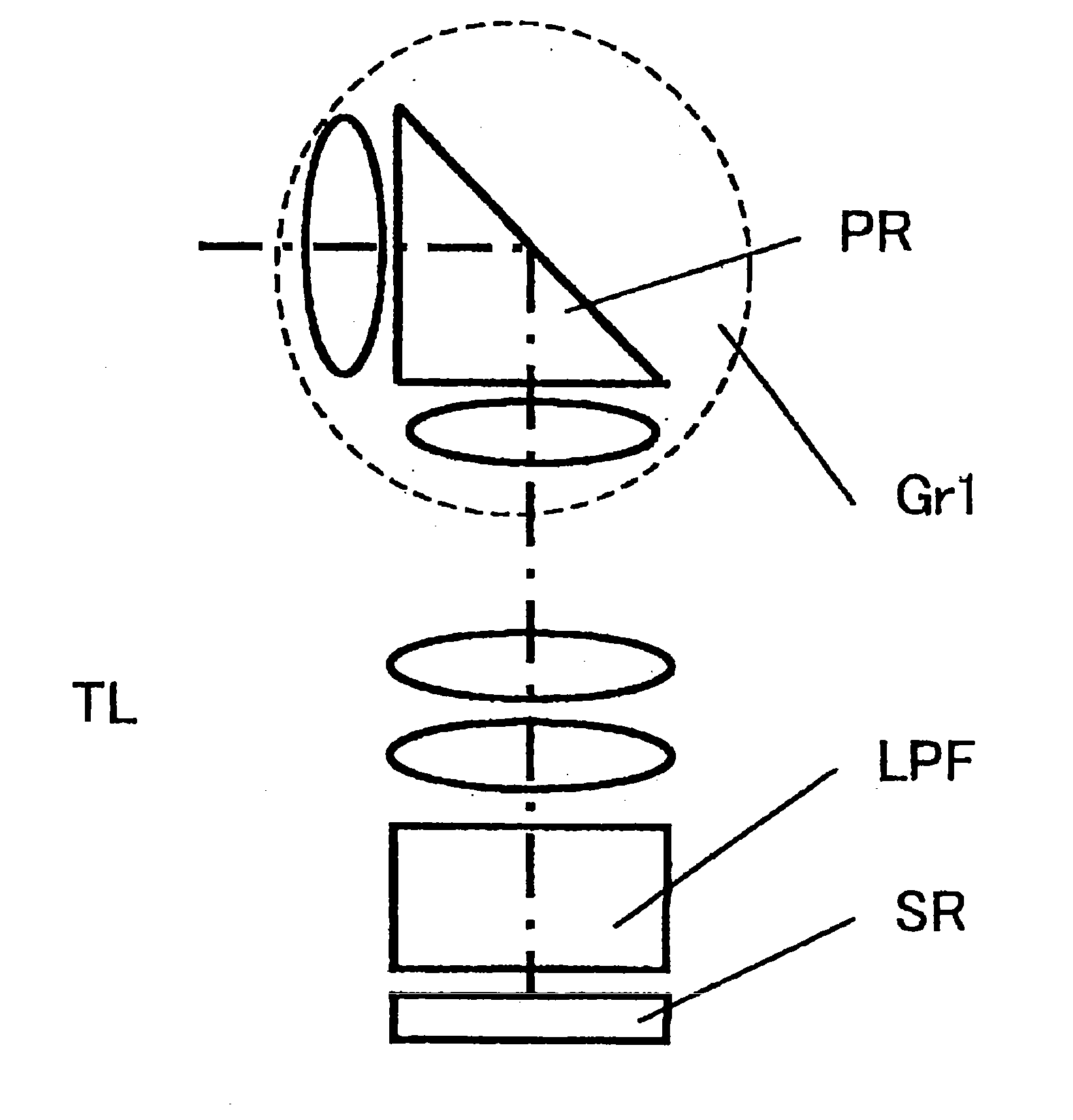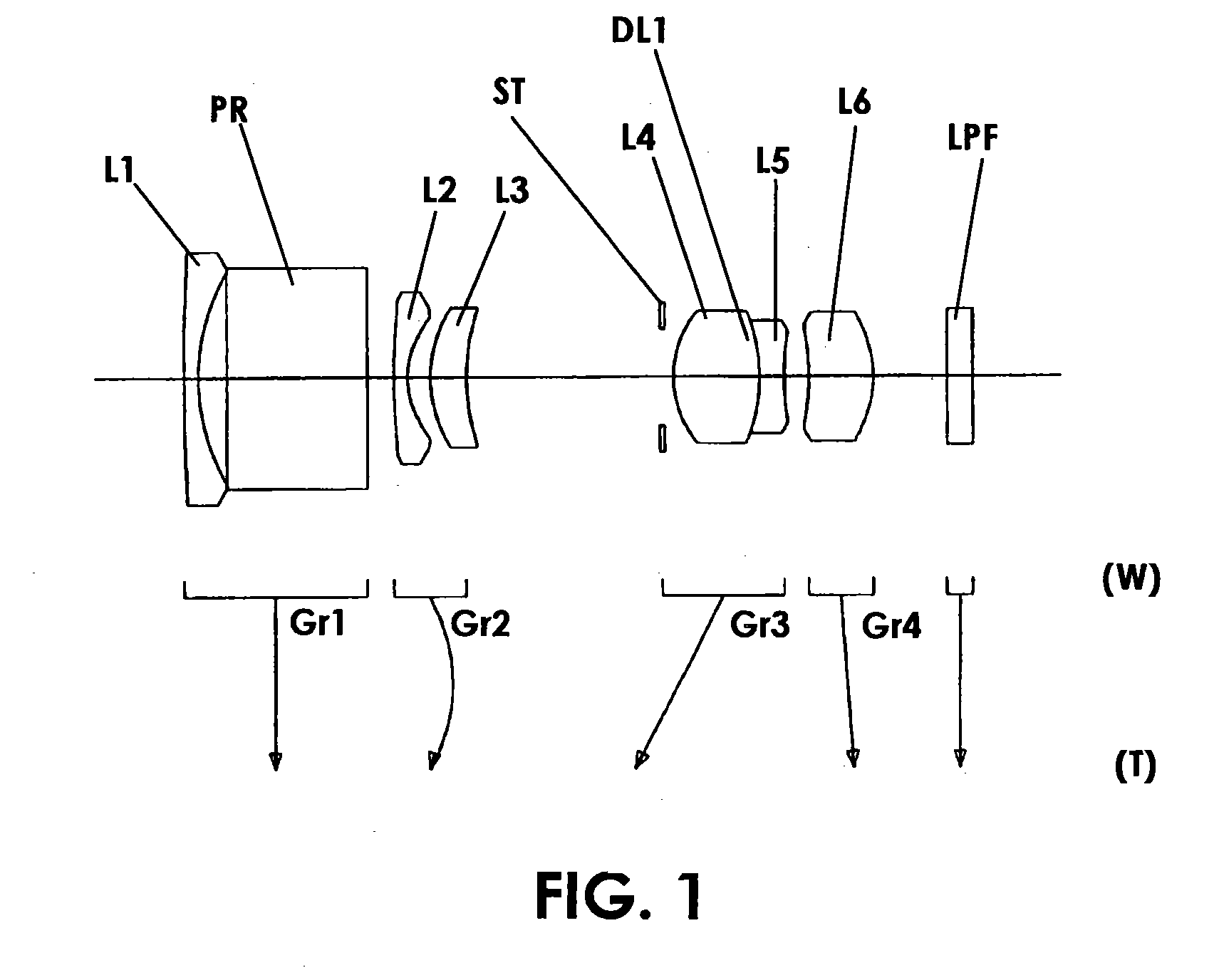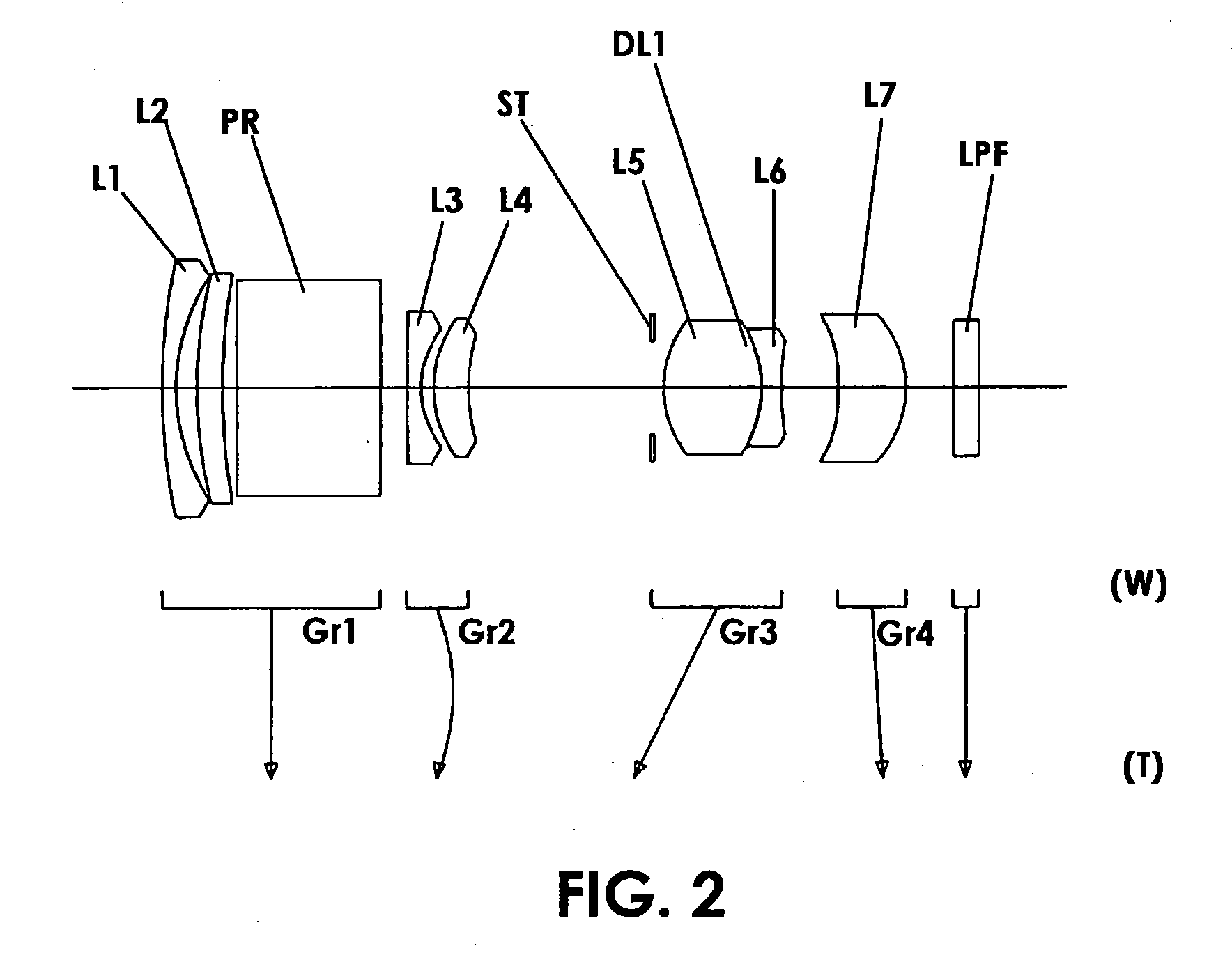Imaging device and digital camera using the imaging device
a technology of imaging device and lens barrel, which is applied in the direction of camera filters, instruments, television systems, etc., can solve the problems of insufficient security of peripheral light, inability to secure the optical performance of image sensors, and difficulty in setting the pupil of the microlens, so as to reduce the cost of imaging devices, improve the degree of freedom of lens barrel structure, and thin optical systems
- Summary
- Abstract
- Description
- Claims
- Application Information
AI Technical Summary
Benefits of technology
Problems solved by technology
Method used
Image
Examples
example 2
[0089]
2 f = 4.5 - 7.9 - 12.9 Fno. = 2.0 - 2.85 - 3.74 [Radius of [Axial [Refractive [Abbe Curvature] Distance] Index(Nd)] Number(vd)] r1 = 33.725 d1 = 0.800 N1 = 1.85000 v1 = 40.04 r2 = 11.351 d2 = 1.200 r3 = 25.554 d3 = 1.458 N2 = 1.75450 v2 = 51.57 r4 = 37.693 d4 = 0.800 r5 = .infin. d5 = 8.200 N3 = 1.84666 v3 = 23.82 r6 = .infin. d6 = 1.500 - 3.420 - 1.500 r7 = 97.822 d7 = 0.800 N4 = 1.52510 v4 = 56.38 r8* = 5.111 d8 = 0.743 r9 = 6.467 d9 = 2.000 N5 = 1.84666 v5 = 23.82 r10 = 10.975 d10 = 10.550 - 4.249 - 1.028 r11 = .infin. d11 = 0.650 r12 = 6.194 d12 = 5.604 N6 = 1.75450 v6 = 51.57 r13 = -6.781 d13 = 0.010 N7 = 1.51400 v7 = 42.83 r14 = -6.781 d14 = 1.183 N8 = 1.84666 v8 = 23.82 r15* = 38.043 d15 = 3.186 - 8.555 - 13.974 r16* = 16.667 d16 = 3.812 N9 = 1.77250 v9 = 49.77 r17* = -5.893 d17 = 2.712 - 1.724 - 1.447 r18 = .infin. d18 = 1.500 N10 = 1.51680 v10 = 64.20 r19 =.infin. [Aspherical Coefficient] r8* .epsilon. = 0.10000000E+01 A4 = -0.15428275E-03 A6 = -0.42877249E-04 A8 = 0....
example 3
[0090]
3 f = 4.5 - 7.9 - 12.9 Fno. = 2.0 - 2.81 - 3.67 [Radius [Axial [Refractive [Abbe of Curvature] Distance] Index(Nd)] Number(vd)] r1 = 15.797 d1 = 0.800 N1 = 1.58913 v1 = 61.11 r2 = 7.557 d2 = 2.700 r3 = .infin. d3 = 8.009 N2 = 1.84666 v2 = 23.82 r4 = .infin. d4 = 1.500 - 3.160 -1.500 r5 = -26.368 d5 = 0.800 N3 = 1.48749 v3 = 70.44 r6* = 4.708 d6 = 0.518 r7 = 5.361 d7 = 2.154 N4 = 1.85000 v4 = 40.04 r8* = 10.802 d8 = 11.235 - 4.910 - 1.331 r9 = .infin. d9 = 0.650 r10 = 6.699 d10 = 4.000 N5 = 1.75450 v5 = 51.57 r11 = -9.744 d11 = 0.010 N6 = 1.51400 v6 = 42.83 r12 = -9.744 d12 = 0.800 N7 = 1.79850 v7 = 22.60 r13 = 67.530 d13 = 0.537 r14 = 28.497 d14 = 0.800 N8 = 1.58340 v8 = 30.23 r15* = 18.947 d15 = 2.612 - 8.560 - 14.167 r16* = - 30.752 d16 = 4.200 N9 = 1.52510 v9 = 56.38 r17* = -5.241] d17 = 2.934 - 1.651 - 1.283 r18 = .infin. d18 = 1.500 N10 = 1.51680 v10 = 64.20 r19 = .infin. [Aspherical Coefficient] r6* .epsilon. = 0.10000000E+01 A4 = -0.10145481E-02 A6 = -0.72075706E-04 A8 ...
example 4
[0091]
4 f = 4.5 - 7.9 - 12.9 Fno. = 2.0 - 2.88 - 3.77 [Radius [Axial [Refractive [Abbe of Curvature] Distance] Index(Nd)] Number(vd)] r1 = 24.847 d1 = 0.800 N1 = 1.85026 v1 = 32.15 r2 = 9.507 d2 = 1.200 r3* = 18.529 d3 = 1.878 N2 = 1.52200 v2 = 52.20 r4 = 37.877 d4 = 0.800 r5 = .infin. d5 = 8.200 N3 = 1.84666 v3 = 23.82 r6 = .infin. d6 = 1.500 - 3.255 - 1.500 r7= -23.840 d7 = 0.800 N4 = 1.52200 v4 = 52.20 r8* = 5.612 d8 = 0.500 r9* = 6.897 d9 = 2.300 N5 = 1.84666 v5 = 23.82 r10* = 17.332 d10 = 11.012 - 4.659 - 1.072 r11 = .infin. d11 = 0.650 r12 = 6.160 d12 = 6.000 N6 = 1.75450 v6 = 51.57 r13 = -6.615 d13 = 0.010 N7 = 1.51400 v7 = 42.83 r14 = -6.615 d14 = 0.969 N8 = 1.84666 v8 = 23.82 r15* = 29.536 d15 = 1.496 - 7.489 - 12.982 r16* = -31.130 d16 = 4.200 N9 = 1.52510 v9 = 56.38 r17* = 5.934 d17 = 3.226 - 1.831 -1.680 r18 = .infin. d18 = 1.500 N10 = 1.51680 v10 = 64.20 r19 = .infin. [Aspherical Coefficient] r3* .epsilon. = 0.10000000E+01 A4 = 0.11455958E-03 A6 = -0.33371789E-06 A8 = 0...
PUM
 Login to View More
Login to View More Abstract
Description
Claims
Application Information
 Login to View More
Login to View More - R&D
- Intellectual Property
- Life Sciences
- Materials
- Tech Scout
- Unparalleled Data Quality
- Higher Quality Content
- 60% Fewer Hallucinations
Browse by: Latest US Patents, China's latest patents, Technical Efficacy Thesaurus, Application Domain, Technology Topic, Popular Technical Reports.
© 2025 PatSnap. All rights reserved.Legal|Privacy policy|Modern Slavery Act Transparency Statement|Sitemap|About US| Contact US: help@patsnap.com



